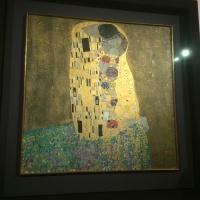Klimt/Schiele: Drawings from the Albertina (Royal Academy of Arts, 4 November 2018-3 February 2019)
The Albertina Collection was founded in 1776 by Duke Albert of Saxe-Teschen and now has a million drawings and prints, which rarely see the light. Here, marking the joint centenary if their deaths we get a joint exhibition of, well, not quite Master and Pupil, but evidently of two of the leading Austrian artists of the first two decades of the twentieth century. As the medium is drawing, and the fame behind Klimt is for paintings such as The Kiss and we probably know Schiele through his drawings, the younger man will win this draw off.
Continue reading →
 I’d managed to forget that Pauline McLynn was in this as Mephistopheles — which is just as well as I would have been channelling Mrs Doyle. “Ah will you not sell your soul, Father Dougal? Ah, go on, go on, go on, go on, go on, go on, go on, go on, go on, go on, go on, go on, go on… Go on, go on, go on, go on, go on, go on…” It does make sense in retrospect — she brings a grotesquery to the role, as well as a cat who has got the cream (with or without tea), as she knows what is to come. There is also a moment when she licks the knife Faustus has used to get blood to sign with — and I’m reminded of Gary Oldman’s Dracula licking Keannu Reeves’s Harker’s cut-throat razor. There is even a physical resemblance.
I’d managed to forget that Pauline McLynn was in this as Mephistopheles — which is just as well as I would have been channelling Mrs Doyle. “Ah will you not sell your soul, Father Dougal? Ah, go on, go on, go on, go on, go on, go on, go on, go on, go on, go on, go on, go on, go on… Go on, go on, go on, go on, go on, go on…” It does make sense in retrospect — she brings a grotesquery to the role, as well as a cat who has got the cream (with or without tea), as she knows what is to come. There is also a moment when she licks the knife Faustus has used to get blood to sign with — and I’m reminded of Gary Oldman’s Dracula licking Keannu Reeves’s Harker’s cut-throat razor. There is even a physical resemblance. All comics end in tragedy, in one way or another. They either die in harness — Tommy Cooper on stage — or fade away to keep bees on the South Sussex Downs or can’t stay at the top. Those giants of silent film — Keaton, Lloyd and Chaplin — transitioned awkwardly into the synchronised sound era, but production slowed or stopped. Stan Laurel and Oliver Hardy were paired together by Hal Roach, with Laurel’s gift for dialogue pairing perfectly with their slapstick. But Laurel never had the financial control he craved and was unable to negotiate a better deal as his contract never ended at the same time as Hardy’s. Laurel left Hal Roach Studios and Hardy made a film with Harry Langdon; thirteen years later the two tour Britain and Ireland in 1953, rebuilding an audience as the has-beens, enjoyed more in reruns than live, and trying to out together one last film. But Hardy is dying.
All comics end in tragedy, in one way or another. They either die in harness — Tommy Cooper on stage — or fade away to keep bees on the South Sussex Downs or can’t stay at the top. Those giants of silent film — Keaton, Lloyd and Chaplin — transitioned awkwardly into the synchronised sound era, but production slowed or stopped. Stan Laurel and Oliver Hardy were paired together by Hal Roach, with Laurel’s gift for dialogue pairing perfectly with their slapstick. But Laurel never had the financial control he craved and was unable to negotiate a better deal as his contract never ended at the same time as Hardy’s. Laurel left Hal Roach Studios and Hardy made a film with Harry Langdon; thirteen years later the two tour Britain and Ireland in 1953, rebuilding an audience as the has-beens, enjoyed more in reruns than live, and trying to out together one last film. But Hardy is dying. This canvas is nice, but it doesn’t quite do it for me. I saw a load of Klimt drawings alongside works by Egon Schiele at the Royal Academy of Arts, but Schiele won. He was, however, key to a generation of Viennese artists before the end of the First World War.
This canvas is nice, but it doesn’t quite do it for me. I saw a load of Klimt drawings alongside works by Egon Schiele at the Royal Academy of Arts, but Schiele won. He was, however, key to a generation of Viennese artists before the end of the First World War.